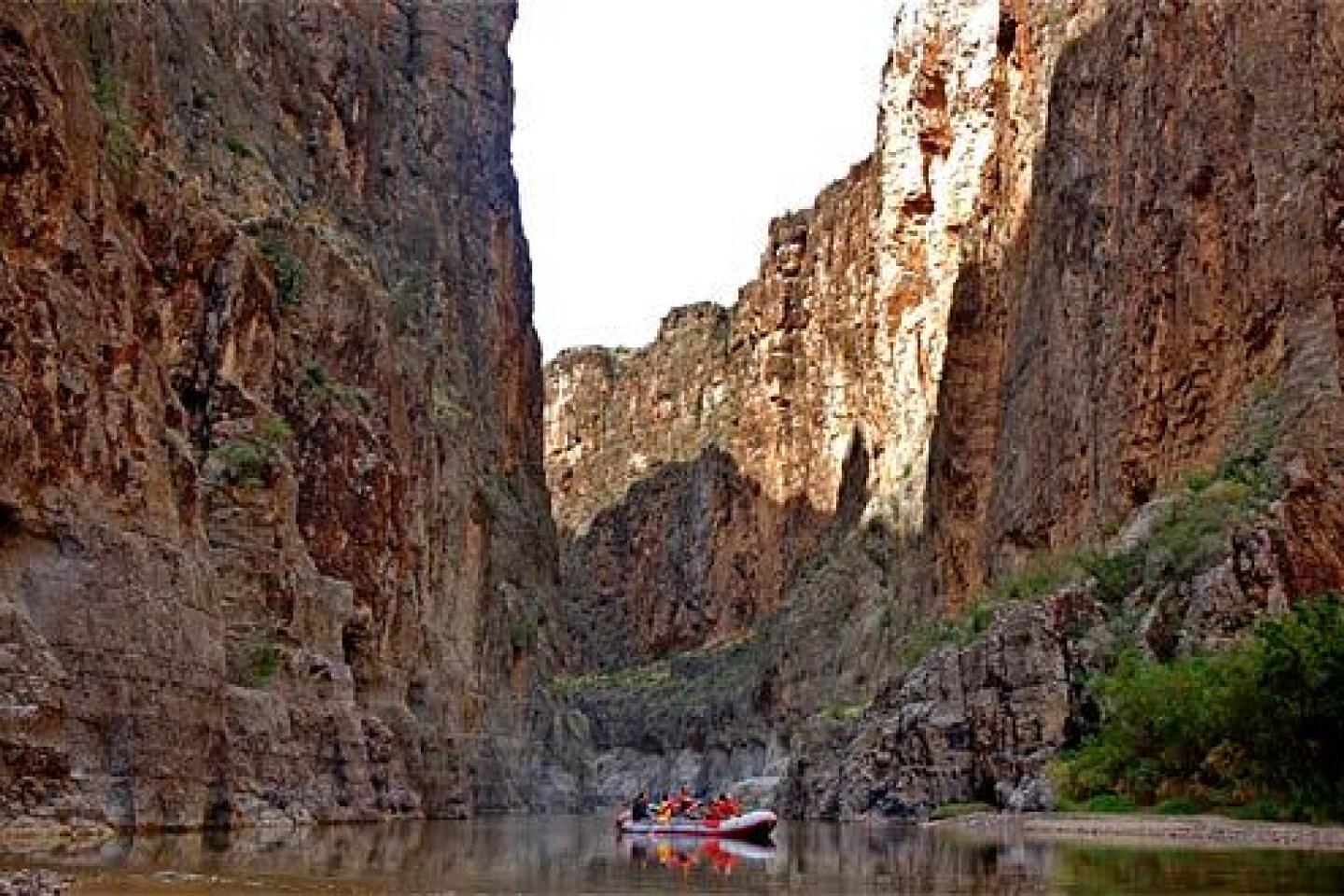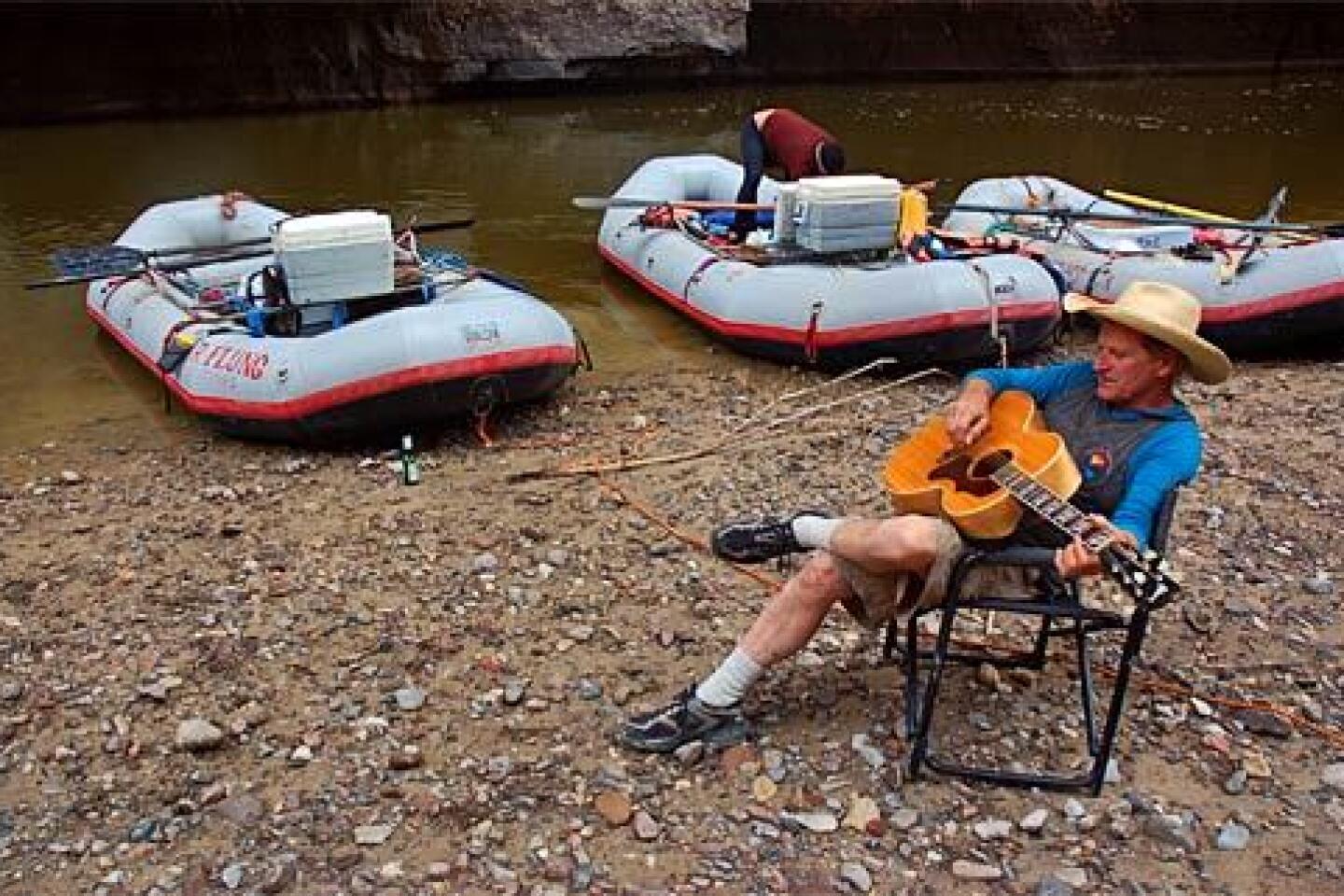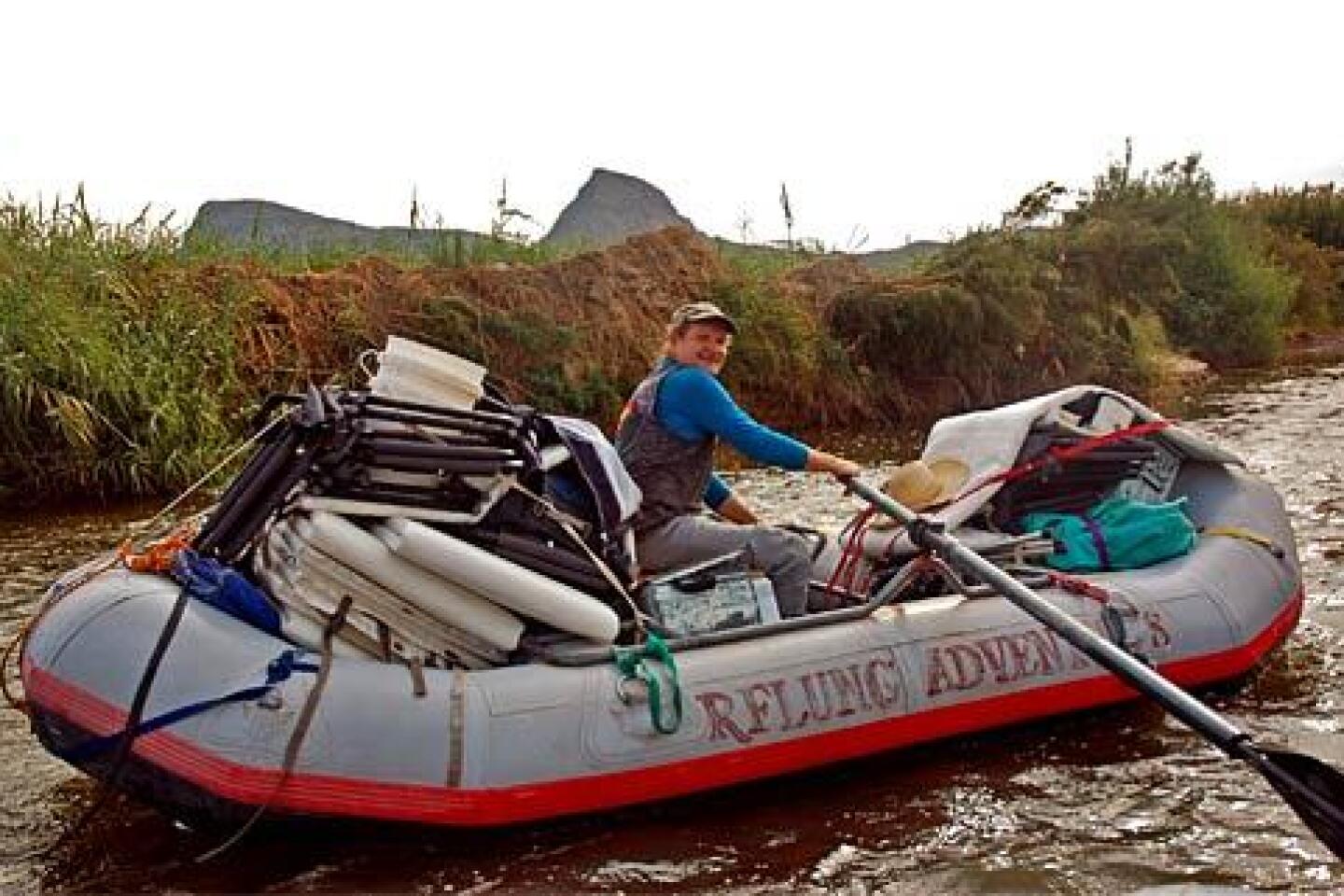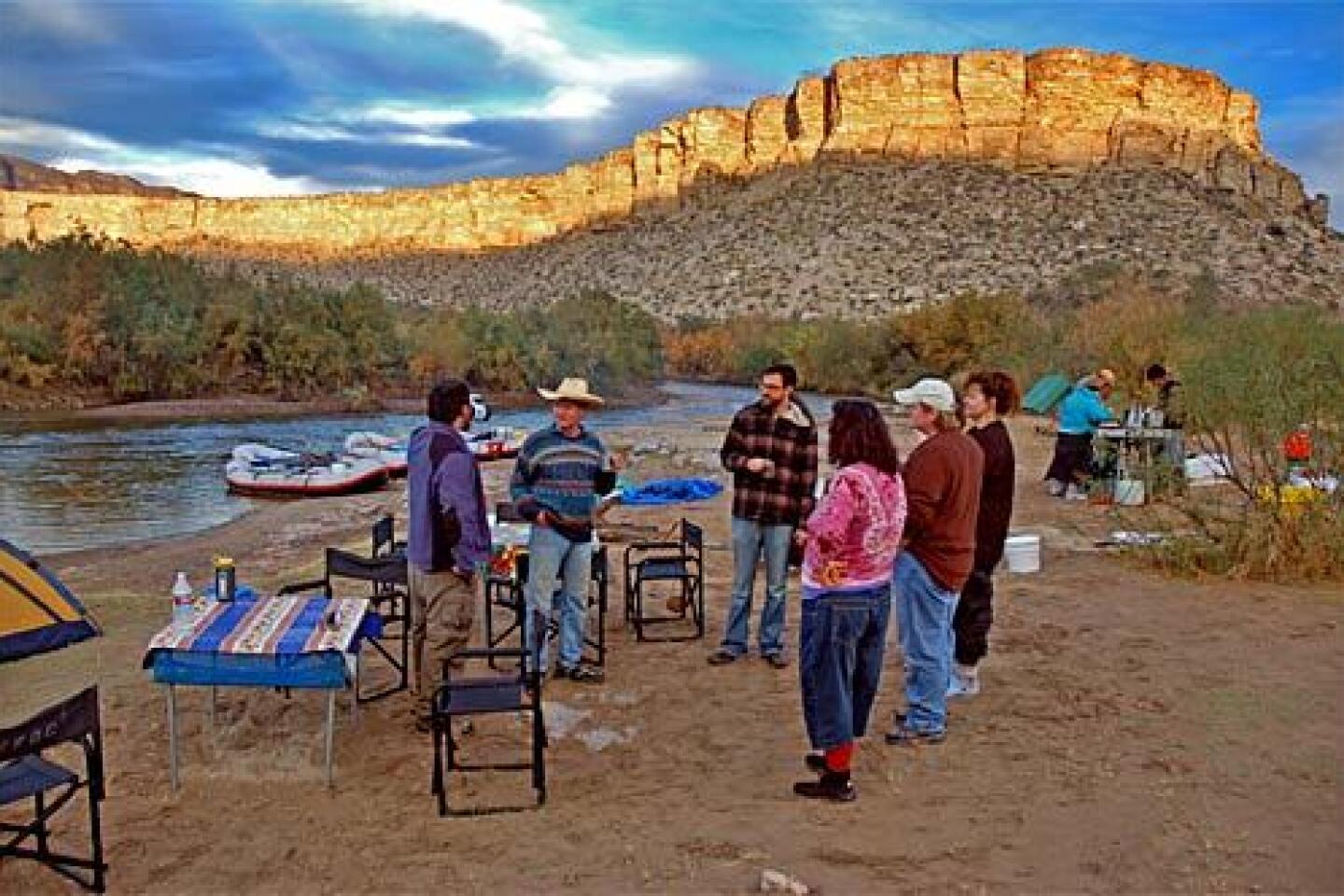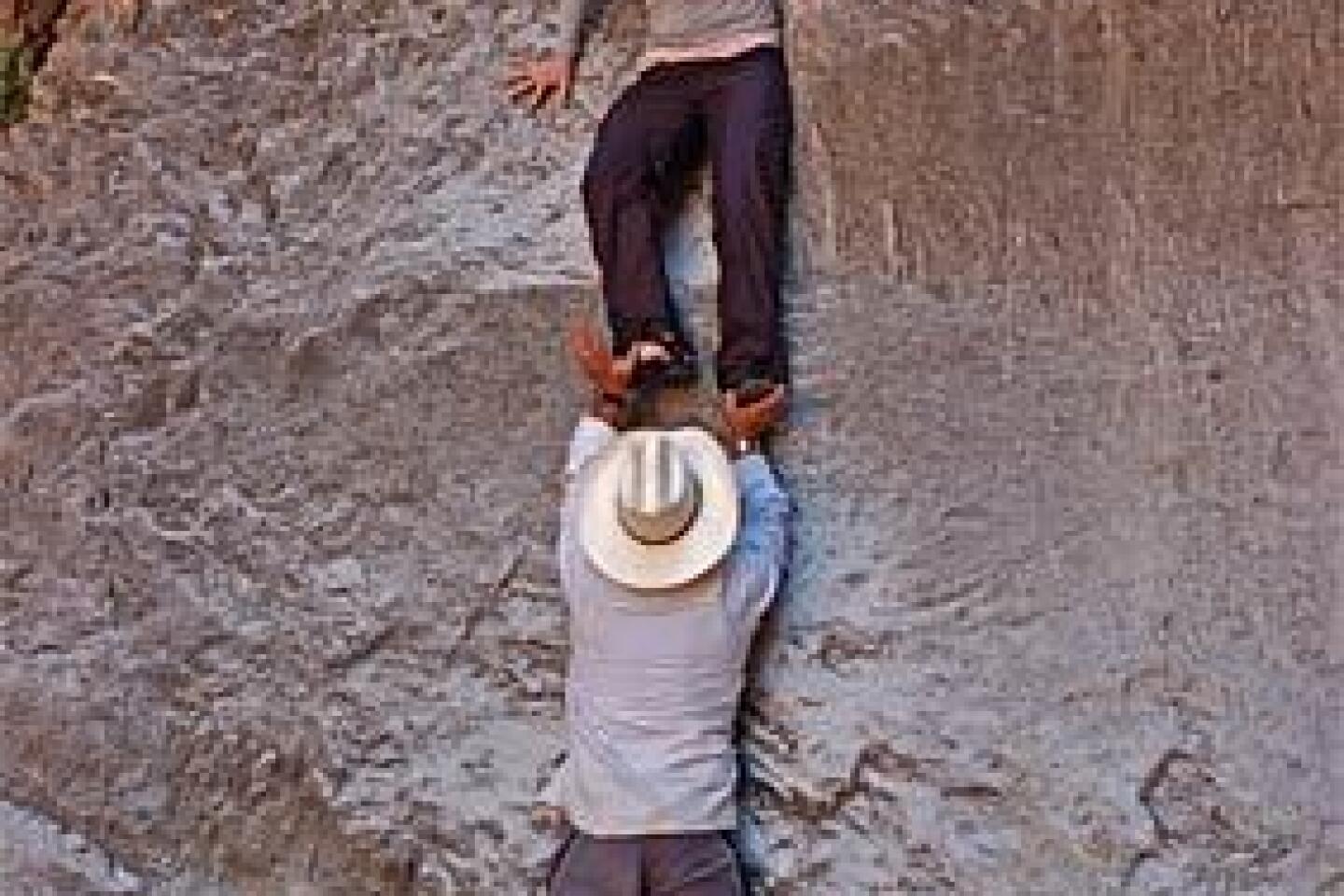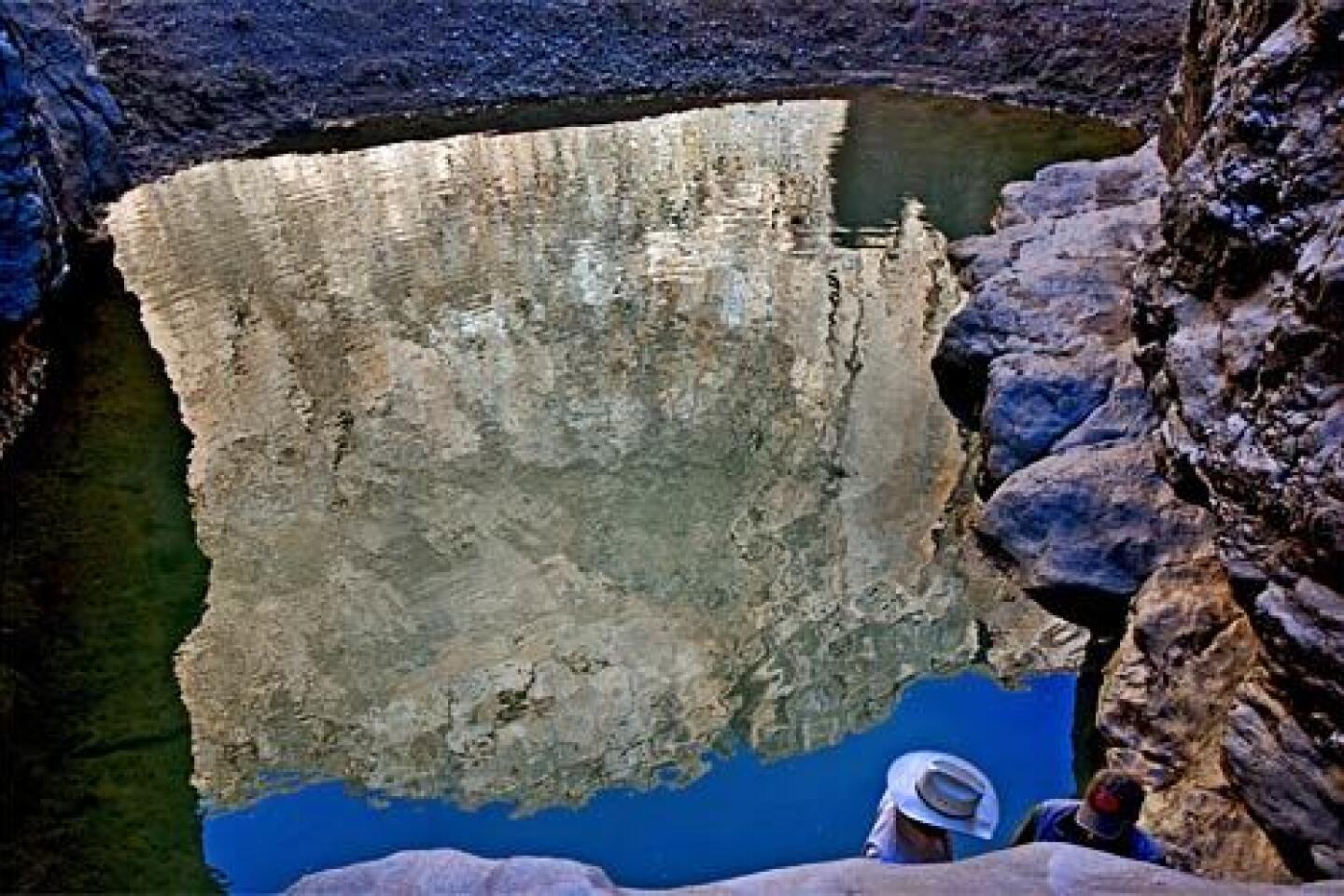Twists and tunes, on a Rio Grande rafting trip
Big Bend National Park, Texas
Butch Hancock probably isn’t the first singer-songwriter to wind up, 35 years after that first promising album, sleeping under a tarp down by the river.
But he is the first one I’ve ever watched wake up.
When I crawled out of my tent that chilly morning, he lay a few yards away, flopped near the water’s edge, barefaced under the sky. Soon the two of us were lined up with the others for coffee from the camp stove.
We had covered 13 miles of the Rio Grande in our rafts the previous day, then camped at the mouth of a canyon, 400-foot limestone walls suddenly jutting into the sky. After dinner, we circled the campfire -- eight customers, three river guides and Hancock, strumming and singing about “bare footprints on the desert sand” and “blue moonlight on the Rio Grande.”
This is a man who has made more than a dozen albums, whose tunes have been sung by Willie Nelson and Emmylou Harris, who has played the Texas governor’s mansion and David Letterman’s show, who generally sleeps at home with his wife and kids.
But Hancock, 62, is also a river rat. On and off for 20 years, he has been joining raft trips run by local outfitter Far Flung Expeditions, which runs two or three musical Big Bend trips every year with homegrown artists.
For me, the Texas scenery was a big selling point, but it was the Texas soundtrack that closed the deal. For my money, there isn’t another state outside Louisiana that can match Texas as an incubator of a sovereign musical culture, one that’s especially rich when it comes to lyrics. Joe Ely, Jimmie Dale Gilmore, Townes Van Zandt, Steven Fromholz, Kinky Friedman, Lyle Lovett, Hancock -- and this list could be much longer. They’re mostly not names you hear on the radio, but they are voices worth hearing.
Now, as the sun threw a morning blush onto the rock-strewn slopes, the guides rustled up breakfast. The rest of the campers came shambling from their tents. Hancock, laconic and perpetually bemused, shared the small talk and also some not-so-small talk involving architect Buckminster Fuller, mystic G.I. Gurdjieff and the teachings of Buddhism.
When we reached the top of a hike to high ground, he dramatically extended an arm to frame the desert panorama below.
“This,” Hancock said, adopting a tone of mock authority, “is actually a perfect example of what can happen.”
Who could argue?
It has craggy mountains, cactus-studded slopes, miles of meandering Rio Grande and a couple of born-again ghost towns at its edge, but Big Bend ranks among the National Park Service’s least-visited parks, and that won’t change any time soon.
The summers are infernally hot. Except for a handful of days per year, rafters can expect nothing more challenging than a Class III rapid. And if you’re from outside Texas, getting here means flying to Midland or El Paso, then driving about five hours while deer, rabbits, coyotes, skunks, armadillos and javelinas scamper and shuffle in and out of your high beams.
On my highway drive in from petroleum-scented Midland, I dodged each of those species at least once, along with another less recognizable furry blur. Chupacabra, maybe. By the time the hills began to undulate and I reached the cheek-by-jowl towns of Terlingua and Study Butte, I had already seen more raw Texas than most outsiders care to.
But there is a payoff.
As the Rio Grande makes it way south and east through the Chisos Mountains -- marking the Texas-Mexico border as it goes -- the river frequently dwindles to 30 feet wide and as little as a foot deep, but the canyon walls leap up toward heaven. Most days, a child can cross the river in the right spot. But that same river can take a rafter to spots that are remote, rugged and gorgeous enough to satisfy even a well-seasoned desert traveler.
On the day we put in, the water was running 300 cubic feet per second, a flow so scant that the outfitter almost put us into canoes, which are better than rafts in shallow water. But we stuck with rafts and put in at Lajitas, about 10 miles outside Terlingua.
First, we drifted past boulders and tamarisks, a sipping horse here, a sunning turtle there. Then the earth began to ripple and rise on either side of us.
Of three major canyons that cradle the Rio Grande as it passes through Big Bend, the deepest is Santa Elena, an eight-mile passage that’s inaccessible by road. And that was the heart of our itinerary, the stretch of water that awaited under those sudden 400-foot cliffs.
Awhile after we’d floated in, my raftmate Pamela Daggett of Austin got quiet.
“This is making me weep,” she whispered.
In wonder and languor, we drifted along, four rafts in a deep declivity in the middle of nowhere. Guides Patrick Harris, Sandi Turvan and Darren Wallace told us about the 22 kinds of bats found in the canyon, the 1,200 kinds of plants, the 450 bird species. Fellow rafter Kelly Schievelbein of Seguin, Texas, who had thoughtfully packed pre-mixed Smirnoff cosmopolitans for the river, offered nips.
Hancock rowed alongside us in a raft freighted with supplies, pausing frequently to pull out a camera and shoot close-ups of weird-looking rocks.
Despite the ideal weather, we spotted just one other rafting group. (In spring and fall, the temperatures along the river usually run 70 to 90 degrees by day, 45 to 60 overnight. Our trip was at the low end of that range.)
Everyone aboard was from Texas except me and Jon and Jodi Houlon, a Philadelphia couple, and most everyone had been hearing for years about the wonders of Big Bend, or listening to Butch, or both.
What, someone asked, inspired the Philadelphians to travel so far? Jon Houlon, attorney by day and frontman by night for a band called John Train, explained how he had discovered Butch Hancock’s music about 25 years ago as a high school student in Maryland. Houlon ordered an album. And because Hancock was then running his own label on a shoestring, he recalled, “I was getting these cassettes in the mail from a trailer park in Austin. My mom was like, ‘What is this?’ ”
Raised on a farm in Lubbock, Hancock wrote some of his first songs while driving tractors. Then in the early 1970s, he and his Lubbock buddies Joe Ely and Jimmie Dale Gilmore formed a group -- a legendary group, in Texas music circles -- called the Flatlanders.
They never set the charts on fire, but through three decades of musical, financial and spiritual ins, outs, ups and downs, all three Flatlanders have forged careers as songwriters and performers, frequently recording one another’s material, often joining for reunion gigs and albums.
Hancock’s songs have always been dense with wordplay, their melodies plaintive, the guitar work plain, the whole package peppered with twangy riddles. In “West Texas Waltz,” he finds rhymes for both “Renaults” and “arthritis.” In “Boxcars,” he says that “if you ever seen the cold blue railroad tracks / Shinin’ by the light of the moon / If you ever felt the locomotive shake the ground / I know you don’t have to be told / Why I’m goin’ down to the railroad tracks / And watch them lonesome boxcars roll.”
Inevitably, given that Hancock works with acoustic guitar, plays harmonica and will never be mistaken for an opera singer, he has often been compared to Bob Dylan. But what’s so Texan, or Zen, about Dylan?
Anyway, Hancock moved in 1997 to Terlingua, where he lives with his wife, son and two stepdaughters in a sprawling, curvaceous, solar-powered home that he’s building, room by room, from concrete, beer cans and recycled materials. They share the property with four Airstream trailers and many, many pets, because his wife, Adrienne, is a serial rescuer.
That first night on the river, Hancock sang 17 songs, including one he introduced as “another true story from West Texas, which is like a triple oxymoron.” He wrapped up with the love song “Bluebird” (an old favorite that Emmylou Harris has covered) and a war song from last year called “When the Good and the Bad Get Ugly.”
Then he thanked us for our applause, pointed up and invited us to join him spotting comets. The headliner, in other words, was deferring to other stars. And in such a brilliant sky, with no competing light source for miles, the gazing was priceless.
The canyon swallowed us the next morning. Floating farther and farther in, we ate lunch in Mexico, which is a fancy way of saying we pulled off the river on the right side instead of the left. We skipped stones by the score, scrambled up a fern canyon for a mile or so, drained a few beers, saw nobody.
By the nightfall on our second camp, still miles from the end of the canyon, the looming walls had reduced the starry sky to a thin twinkling strip directly above us. Hancock’s lyrics bounced around the canyon like bats on the wing, which were present in great numbers as well. And when I rose from my folding chair at the campfire to stretch my legs, there stood my shadow on the far wall, 75 feet high and flickering. Bright or dim, a handsome canyon.
“I thought it was going to be pretty, but it’s just breathtaking,” said fellow rafter Dottie Hall.
Hancock played a little longer that second night -- about 25 songs, including a couple by Dylan and at least three by Townes Van Zandt, including the one everybody knows, “Pancho and Lefty.”
For a few minutes he handed the guitar to Houlon, who couldn’t resist playing Johnny Cash’s “Big River.” Somebody pulled out a bottle of whiskey. Soon it was 11.
“I don’t want to go to sleep,” Houlon said, “because then it’ll be tomorrow.”
But in the end he did, and it was. We broke camp, eased back into the slow flow and watched the cliffs stretch up to about 1,400 feet, then dwindle to nothing. We skipped a few hundred more stones into Mexico. (Somebody, check a satellite photo, and I’m sure you’ll discover that Texas lost territory between Nov. 29 and Dec. 2.)
Then we turned a corner, and it was all over. The sky, that narrow sliver overhead from the night before, was big again. A telephone pole rose in the distance. You could see trails along the shore. Cars. People.
Damn, I thought. And then I remembered a line that Hancock muttered somewhere along the river, saying he was saving it for the right song: “What a world this mess is in.”
chris.reynolds@latimes.com
More to Read
Sign up for The Wild
We’ll help you find the best places to hike, bike and run, as well as the perfect silent spots for meditation and yoga.
You may occasionally receive promotional content from the Los Angeles Times.
